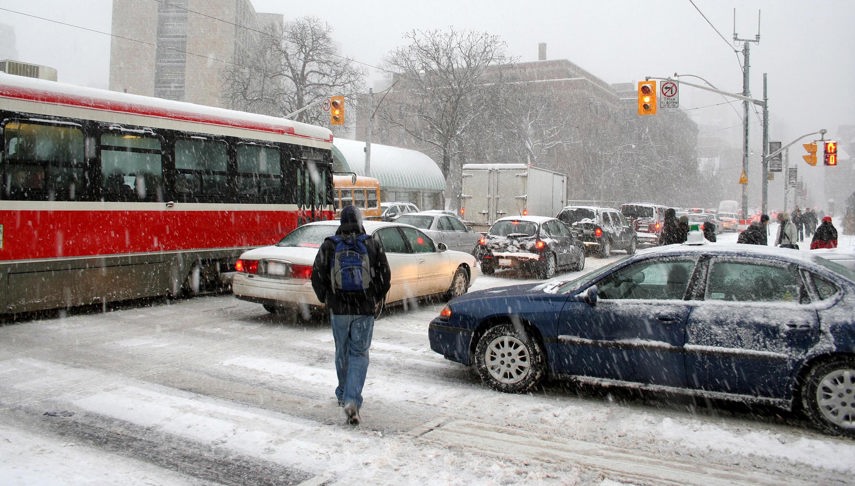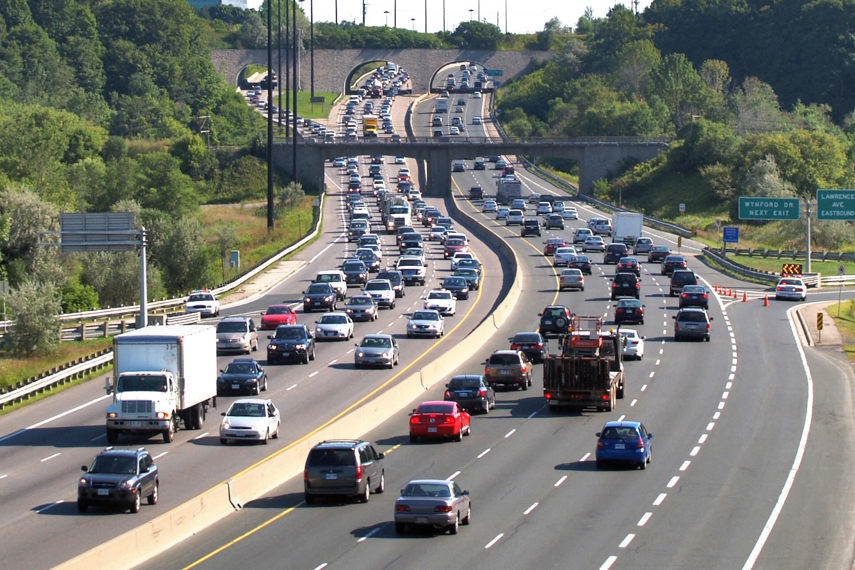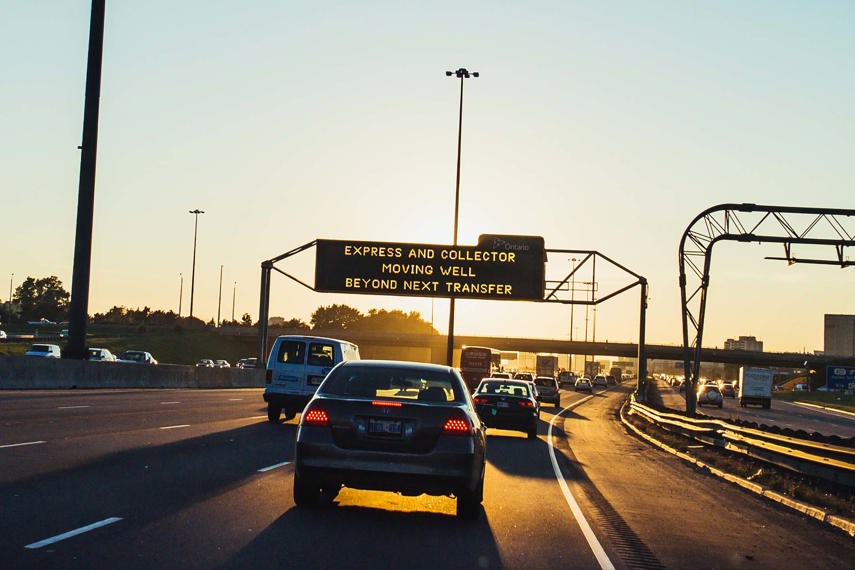If you’ve ever spent any time in the downtown area of a big city, you’ve noticed it. One or two vehicles will try to inch their way through an intersection at the last moment, leaving a bumper or three poking out into the perpendicular lane.
This slows the approach of other vehicles, which causes cars and buses further down the line to grind to a halt – a chain reaction that repeats ad nauseum until the entire downtown core is at a standstill. One small blockage several streets away can wreak havoc on the ability to successfully navigate your way to Walker’s Hardware on a quest to buy new shear pins for an ancient snowblower.
Maybe that’s a destination strangely specific to me.
Our point stands: gridlock sucks. But, as anyone who’s ever played “SimCity” (or, more recently “Cities: Skylines”) can tell you, there are solutions. Actual urban engineers – and not just automotive journalists who like to play them in simulations – have long advocated for creative solutions to gridlock, saying some plans either simply move the problem from one place to another. A study by a group called Smarter Transport in the UK makes the point that some “one-hit solutions” like wider streets provide only temporary relief since most drivers adapt their lifestyles to prevailing road conditions. Traffic capacity might be freed up initially, say the experts, but the phenomenon of induced demand will eventually fill up the road space once more – at which point we’re back to gridlock.

So, what are frustrated drivers to do? We’ve assembled a list of ideas to help alleviate gridlock, some of which require absolutely no investment beyond enforcing rules already in place or the deployment of simple common courtesy by drivers. Other suggestions on this list have proven contentious in some corners of the internet.
And if you find a deal on shear pins for a three-stage Cub Cadet snowblower, I’m all ears.
Driving Courteously – and Predictably
As most of us were taught in kindergarten, it doesn’t cost anything to have manners. While it is true there are thousands of players involved at any one time on the downtown streets of a major city, some common sense can go a long way toward maintaining good traffic flow. Being territorial about our space, jumping from lane to lane, and cutting off other cars rarely help matters when trying to navigate a densely packed urban area.
Courteous is good – but not too courteous. We’re talking about nixing well-intentioned but boneheaded moves like stopping in a thoroughfare to let someone out of a side street, waving pedestrians across the road when there’s no crosswalk, and essentially any other activity that would surprise other motorists and impede traffic.
Correct Use of Legal Manoeuvres

Remember the “territorial” comment from two paragraphs ago? It’s not uncommon for people to get incensed near construction zones when a lane closure forces two lines of traffic to merge. Your author has witnessed miles of tailbacks thanks to all hands immediately shifting to the one open lane, even though the other lane doesn’t close for another several hundred metres. In a perfect world, drivers would stay in both lanes right up to the merge, theoretically reducing the line of traffic by half since there are two lines of cars instead of one. At the merge point, cars would advance one at a time, slotting into the open lane like individual teeth in a closing zipper.
An issue arises when some people think a driver who’s attempting a zipper merge is jumping the line and refuses to play ball. While it is true there are some jerks who will zoom through a closed lane and try to interrupt the queue, proper zipper merging will help prevent traffic jams. Having an officer on hand to facilitate this would help immensely.
Inbound Flow Control
Some suggestions, including this one, are often referred to by city planners as virtuous measures. These are actions or events that reinforce a particular type of behaviour, subtly reshaping commuter habits over time until they add up to a major shift in driving conduct.
Readers who brave certain 400-series highways in Ontario will be familiar with this tactic. Traffic lights on the on-ramp are used to release vehicles only as fast as the road ahead can carry them, restricting flow at peak times to reduce congestion. The 400-series highways use this idea at certain on-ramps, while proponents of using it to prevent downtown gridlock lobby for its inclusion at the edge of the city. Some highway on-ramps close entirely during peak hours, routing drivers through a detour to reduce volume and congestion.
Dynamic signs could inform drivers of wait times or point them to the nearest point of public transit. Advocates suggest congestion is broken up before it’s even started – like someone breaking up river ice so it can flow smoothly further downstream. If there are jams, they’re kept outside the downtown core and in a space where there is (theoretically) more land space. A slip road at these lights would allow emergency services or transit to run unimpeded.
Traffic Light Optimization

Even if a municipality doesn’t want to shovel untold capital into new traffic lights as proposed in the previous suggestion, there is likely room for improvement in their existing control system. If you’ve ever noticed the propensity to “catch the lights” on a particular stretch of roadway, there’s a solid chance you experienced the realization of an urban planner’s efforts to synchronize a series of traffic lights to optimize vehicle flow. When it works, it’s great.
Of course, the real world tends to get in the way of these best laid plans. Any hiccup in traffic flow – unexpected slowdowns due to jaywalkers and weather-related delays are just two examples – can toss this timing right out the window. So-called “smart programming” responds to demand in real-time, aided by cameras and the like. Road capacity can be maximized quickly by syncing itself to the movement of larger vehicles or conditioned to respond appropriately to situations like gridlock or blockage. All of this programming can be done with expert knowledge of the non-linear relationship between traffic flow and delay.
Congestion Charges
Here’s a tactic that is sure to raise some ire and cause our email inboxes to burst at the seams. One way to avoid gridlock, proponents of these measures claim, is to simply reduce the number of vehicles in a downtown core at any given moment. Adding fees and charges for entering certain parts of a city is an approach deployed by many major metropolitan centres, with the stated goal of getting drivers to park their machines on the outskirts of town and take transit to their final destination.
In this same vein, a few municipalities have dabbled with the idea of restricting cars into gridlock-prone areas of town based on their licence plate. Some deploy an “odds and evens” strategy, for example, in which vehicles with a tag ending in an odd number cannot enter the city on an even-numbered day of the month (and vice versa). Of course, wealthy people get around this by simply having two cars with opposing plates.
V2X Technology

The final entrant in our list is the rise of so-called “vehicle-to-everything” or V2X technology. This refers to the digital sharing of traffic information not just between vehicles but also between traffic control systems and vehicles. Connected video cameras can inform motorists about congestion or delays, prompting the car’s navigation system to plan a different route for the driver, helping them avoid the problem instead of adding to it.
Some of these tools are already in place – and some, like Waze, even use crowdsourcing – but a wholesale and concentrated deployment of this information in specific areas would create the likes of smart transit corridors. This would arm drivers with knowledge of upcoming traffic conditions, permitting them the chance to either reroute their plans away from congested areas or slow down before they arrive at the problem to evade further crowding.

